The Lowdown: Social Media Marketing Software 📈
- Classification remains ambiguous. Social technologies lack a universal classification system, making it challenging for B2B buyers to discern the nuances. Peer-to-peer software review platforms offer insights, but their categorizations can sometimes be misleading, emphasizing the need for clarity in this dynamic sector.
- Cost and adoption pose challenges. While the allure of social media marketing software is evident, the financial implications can deter smaller brands. Beyond the monetary aspect, integrating new platforms demands seamless onboarding and training, given the potential steep learning curves associated with some tools.
- Privacy and security take center stage. The rise of regulations like GDPR and CCPA has heightened the importance of data protection. Brands must ensure their chosen software aligns with these mandates, navigating the intricate landscape of data collection and compliance.
- Strategy precedes software selection. Before diving into the vast ocean of social media software, brands must craft a robust content strategy. This foundational step ensures that the chosen platform aligns seamlessly with overarching goals, maximizing ROI.
- Audience engagement hinges on listening. Engaging with audiences is more than mere broadcasting; it’s about tuning into their conversations. Platforms like Sprout Social empower brands to monitor discussions, offering invaluable insights into audience preferences and sentiments.
- Influencer identification is an art. In the digital age, influencers wield significant power. Identifying influencers requires a blend of art and science, assessing factors like topical authority and network size. Tools like BuzzSumo and Klear streamline this process, ensuring brands connect with the most impactful voices.
- Text analysis offers unparalleled insights. Platforms like Quid and Graphext transcend traditional social media monitoring, delving into the deeper meanings behind conversations. By harnessing advanced technologies, these tools give brands a nuanced understanding of the digital landscape, enabling more targeted and resonant marketing strategies.
What is Social Media Marketing Software?
Social media marketing software is a digital toolset designed to aid businesses and individuals in managing, monitoring, and optimizing their social media campaigns and activities. This software typically offers features such as content scheduling, audience engagement tracking, analytics, and reporting. By centralizing various social media tasks, it allows users to efficiently execute and measure their strategies across multiple platforms, ensuring consistent branding, timely interactions, and data-driven decision-making.
Classifying Social Marketing Software
While many strive to guide B2B buyers through the maze of social media technologies, the clarity often remains elusive. Peer-to-peer review platforms, such as G2 and Trust Pilot, step in by offering in-depth insights derived from user feedback. They not only present comprehensive reviews but also rank software providers based on data from ads, web sources, and social platforms.
For context, consider the G2 Grid® for Social Media Analytics, which mirrors the essence of Gartner’s Magic Quadrant.
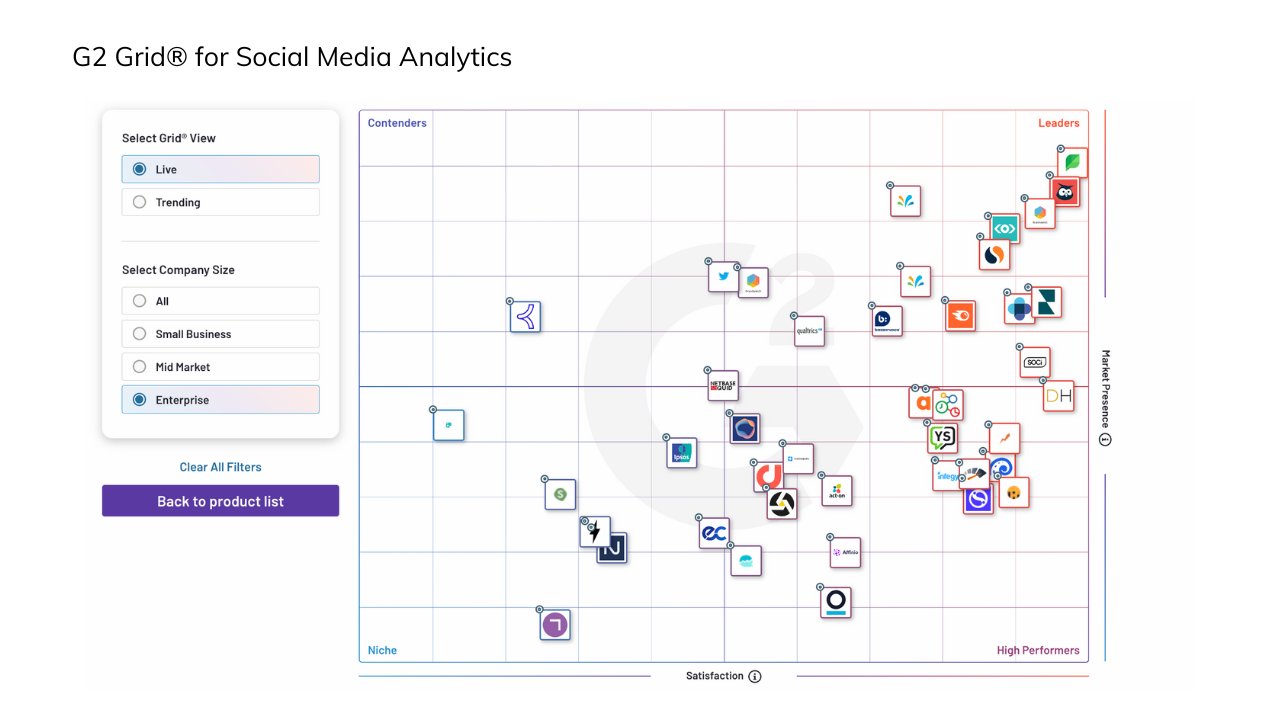
However, a hurdle with these platforms is their tendency to slot social technologies into multiple categories, occasionally misclassifying them. As the landscape of social technology becomes more cohesive, buyers need transparency regarding their tech investments and the specific challenges these tools address.
It’s paramount to note that the realm of social technology is in constant flux, undergoing continuous transformation. Keeping abreast of social media technologies‘ latest shifts and trends remains indispensable.
The Challenges of Navigating Social Media Marketing Software
Brands today have several challenges with identifying and implementing social media software. The most significant obstacles are cost, adoption, privacy, and security. Let’s delve into these issues to understand better the hurdles marketers face.
The first challenge is cost. Investing in social media marketing software might seem expensive for smaller brands and start-ups. There are various options, from budget-friendly tools to enterprise-grade software solutions, but finding the right fit can be challenging. Therefore, companies must carefully evaluate their needs, resources, and objectives.
Next is adoption. Introducing new social software requires a smooth onboarding process and employee training. Some platforms have steep learning curves; not every team member can adapt quickly. Ensuring everyone is on the same page and takes the software’s capabilities.
Privacy and security concerns have become a significant priority in recent years. With regulations like GDPR and CCPA in place, companies must be vigilant in safeguarding customer data. In addition, they must ensure their software complies with these regulations to avoid potential legal and financial ramifications. Unfortunately, navigating these complex requirements can be a minefield for marketers who don’t fully understand the social marketing technology industry and how data is collected.
Marketers should constantly assess risk and be prepared for unforeseen challenges. For example, social media platforms can change policies, restrict data access, or introduce new features that impact software compatibility.
Best Practices of Social Media Marketing Software
Crafting a well-thought-out content strategy is critical before considering which social media software platform to invest in. Imagine being an architect; nobody would start building a skyscraper without a blueprint, right? Similarly, having a solid plan guides the choice of software and ensures the selection of a platform that complements goals and objectives.
Once a decision is made on the right social software, it’s time to establish a content calendar and schedule posts. Automated social media marketing software tools like Buffer and Hootsuite can post to multiple channels simultaneously and have built-in algorithms to post at optimal times.
Analyzing content performance and conducting A/B testing across all channels offers a bird’s-eye view of what works and doesn’t. Most social media intelligence software platforms simplify this task by allowing simultaneous posting and comparison of results across multiple channels.
Next, connecting with the audience and establishing lasting relationships is essential to practicing social listening. Like a skilled detective, sharpening listening abilities and keeping tabs on discussions concerning the brand is crucial. Sprout Social proves helpful in tracking social media conversations and gaining insight into the audience’s interests.
Identifying influencers demands a keen eye and a systematic approach. Start by ranking them based on their topical authority, network size, and other factors relevant to the brand. It’s like drafting a sports team; the goal is to pick players that boost the team’s overall performance. Tools like BuzzSumo and Klear make this task a walk in the park, helping zero in on the right influencers.
Lastly, staying updated with industry trends and platform changes is essential. Picture being a captain navigating the ever-changing seas of the digital world; keeping a sharp eye on the horizon helps clear any obstacles. Subscribing to industry newsletters, following thought leaders, and attending webinars ensure staying one step ahead.
Five Types of Social Marketing Software
| Type | Description | Challenges | Opportunities |
|---|---|---|---|
| Social Media Marketing Software | Streamlines content dissemination and engagement across various social platforms. | Overwhelming platform choices, Adapting to platform updates | Consistent branding across platforms, Real-time engagement |
| Social Media Listening Software | Monitors and analyzes global conversations, providing insights into brand mentions and sentiments. | Data access restrictions, Noise filtering | Immediate feedback on campaigns, Crisis management |
| Audience Analysis Software | Offers deep insights into audience segmentation, preferences, and behavior. | Data accuracy, Keeping up with dynamic audience behaviors | Targeted content delivery, Improved ad targeting |
| Influencer Marketing Software | Identifies, manages, and collaborates with digital influencers to amplify brand messages. | Identifying genuine influencers, ROI measurement | Expanded brand reach, Authentic brand promotion |
| Text Analysis and Network Mapping | Analyzes textual data for patterns and sentiments, and maps online interactions to reveal influential nodes. | Handling vast data volumes, Contextual interpretation challenges | Deep insights into audience sentiments<br>Identification of emerging trends and influencers |
Succeeding today requires brands to navigate an increasingly complex digital landscape. While some cling to traditional analog tactics, savvy marketers assemble sophisticated digital toolkits to maximize their online impact.
Centralized social media management platforms like Hootsuite and Sprout Social provide vital functionality for organizing expansive social campaigns. These tools enable brands to implement coordinated strategies across their social media presence by consolidating content publishing, engagement, and analytics. Rather than taking a fragmented approach, these platforms allow for unified visibility and control.
Monitoring tools like Meltwater and Talkwalker offer invaluable social listening capabilities. By tracking keywords and hashtags, brands can gain real-time insights into relevant online conversations. These tools analyze sentiment, influencers, trends, and more by applying natural language processing and machine learning algorithms. Listening enables brands to identify opportunities and threats, react quickly, and refine strategies based on data-driven insights.
Leading social media management platforms provide detailed audience analysis features. By harnessing data points ranging from demographics to interests to past engagement, brands can segment their followers into distinct brand personas. Tailoring content and messaging to align with each persona’s preferences leads to enhanced relevance and engagement. Audience insights allow brands to implement targeted strategies at scale.
Dedicated influencer marketing platforms like Traackr and Upfluence are purpose-built to identify and manage influencer partnerships. By scanning the social web for relevant creators, these tools enable brands to connect with digital mavens in their niche. Strategic collaborations with influencers provide brands with credible third-party endorsements and expanded reach.
By combining these advanced tools, modern brands can gain comprehensive insights, increase relevance, react nimbly, and maximize the impact of their social media efforts. With the right toolkit, brands can thrive amid the ever-shifting digital marketing landscape.
The Basics: Social Media Marketing Software
Picture this: social posting software that enables you to publish content on various social media channels without logging in and out of each one. It sounds like a dream, doesn’t it? Well, that’s precisely what social media marketing software is all about.
Rewind to the early days of social media, around 2008 and 2009, when only a handful of platforms published content directly to social media channels. Fast forward to today, and we see an explosion of options in the market. Brands like Hootsuite, Sprout Social (below), and Hubspot Marketing Hub have been early birds in this space, thus securing a firm grip on the market, especially for small businesses.
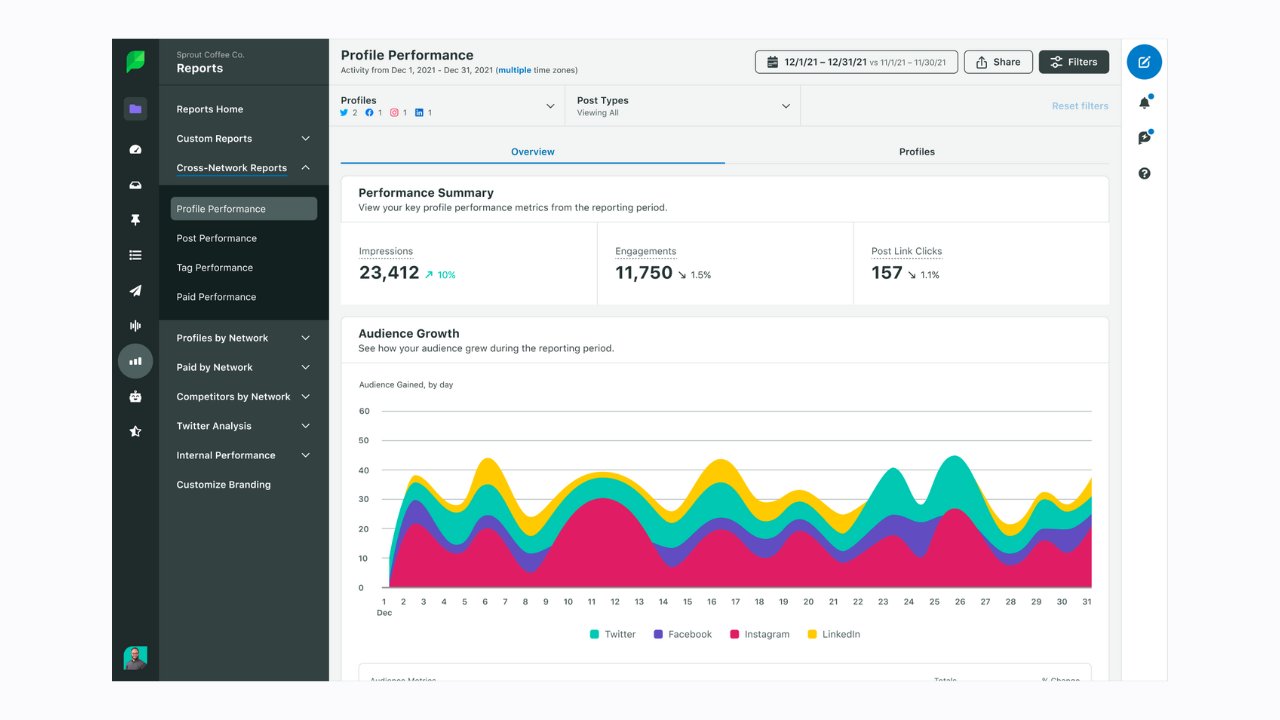
But wait, there’s more! Buffer, Agorapulse, and Later are also worth checking out. While they all have unique features to some extent, their core functions are similar.
Meanwhile, for the big players – the enterprise brands – Sprinklr, Khoros, and the Salesforce Marketing Cloud lead the pack. Over time and thanks to a series of acquisitions, software for social media has expanded its capabilities to include customer experience, content management, social listening, brand advocacy, influencer management, communities, and social care.
While Khoros provides various software solutions, they have become known for their best-in-class social media customer service software.
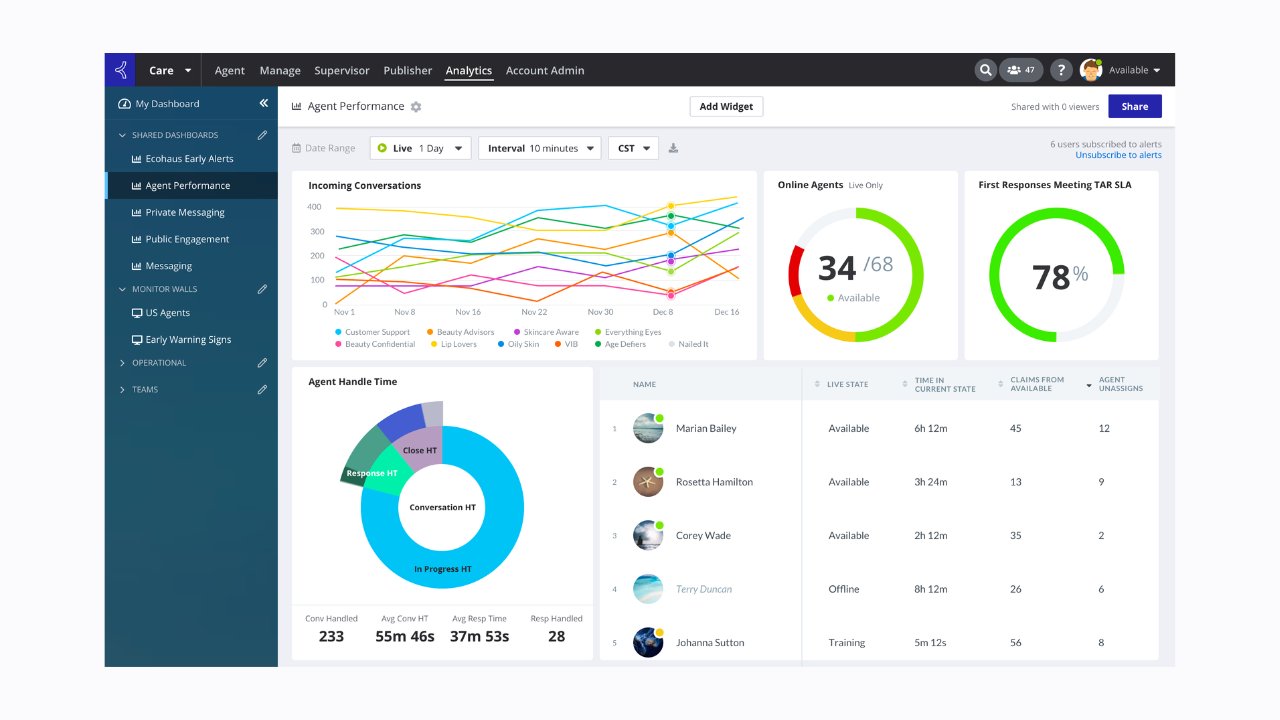
Not to be left behind, Falcon (acquired by Cision) and Meltwater offer similar features. But before you make a beeline for a social technology vendor, let’s take a step back and mull over the essentials:
- Governance: Can the software protect your company passwords and customer data? This aspect is crucial for large enterprise brands juggling multiple handles and global channels.
- Content & Editorial Approvals: Does the tool allow you to set up content approval processes? This feature is vital for streamlining content ideation, creation, approval, and publishing across teams.
- Escalation Workflows: This is a must-have for effective community management, customer care, and managing a PR crisis.
- Dashboards: A social media dashboard is a one-stop shop for performance metrics and analytics across all channels, offering different views and insights.
- Paid Media: Integrating paid media activation with comprehensive reporting can boost efficiency for digital campaigns and organic social media management.
So there you have it – a comprehensive rundown of social media marketing software options. Whichever you choose, rest assured that these tools can help streamline your social media management and improve your online presence.
The Lowdown on Social Media Listening Software
Social media listening software enables you to monitor and analyze conversations across news media, blogs, forums, and social media. Keep in mind that platforms like Facebook, LinkedIn, and Instagram put the brakes on the data these tools can access. So if a technology vendor claims otherwise, feel free to raise an eyebrow and ask questions.
The market for social media listening tools is chock-full of options. While I’ve written extensively about vendors I’ve worked with before, let me share a few key points. In my experience, software companies with a single-minded focus push the envelope and offer top-notch service. That’s why I’m not over heels for social media management platforms that strive to be jacks of all trades. It’s not that their products are terrible; it’s just that they aim to cover all bases for enterprise companies by monitoring every PESO channel, which means they may not excel in specific features.
In contrast, social listening vendors pour their energy, efforts, and development resources into refining insights and analyses for clients.
Forrester does shed some light on this area, although they dub it “AI-enabled Consumer Intelligence platforms.” However, my bone to pick with them is that they overlook several excellent vendors for various reasons.
Small businesses might want to check out Keyhole, Brand24, YouScan, Mentionlytics, and Mention. Unfortunately, most smaller social listening vendors have become commodities, lacking standout features or differentiation.
I’ve been keeping tabs on and curating all the social media monitoring tools I’ve used or reviewed. Top contenders include Infegy, Brandwatch, Netbase Quid, Synthesio, Pulsar Platform, and Talkwalker. Take, for example, Infegy, which boasts one of the most robust text analytics tools on the market.
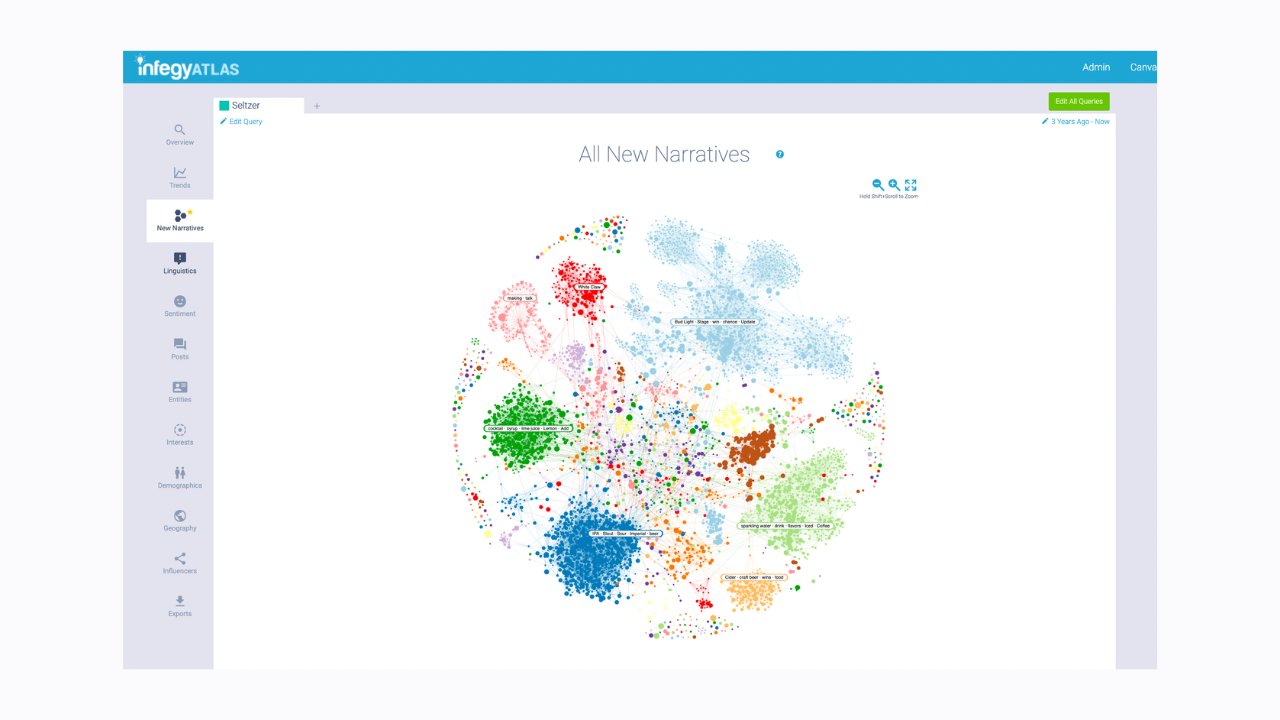
It’s also crucial to consider the ethical aspects of social media technology concerning data and consumer privacy. As mentioned, some platforms limit access via their APIs, so be cautious of vendors claiming access to such data.
Decoding Audience Analysis Software
Audience analysis software helps you create audiences, break them down into smaller sub-groups, and scrutinize their media affinities and social media conversations.
I’ve assembled a list of top-notch audience analysis tools and software to save you some legwork. In past musings, I’ve explored the distinction between audience intelligence and social listening. To clarify, social listening offers insights into what the world says about a topic, brand, or competitor. Conversely, audience intelligence zeroes in on what a particular group says, focusing on audience segmentation.
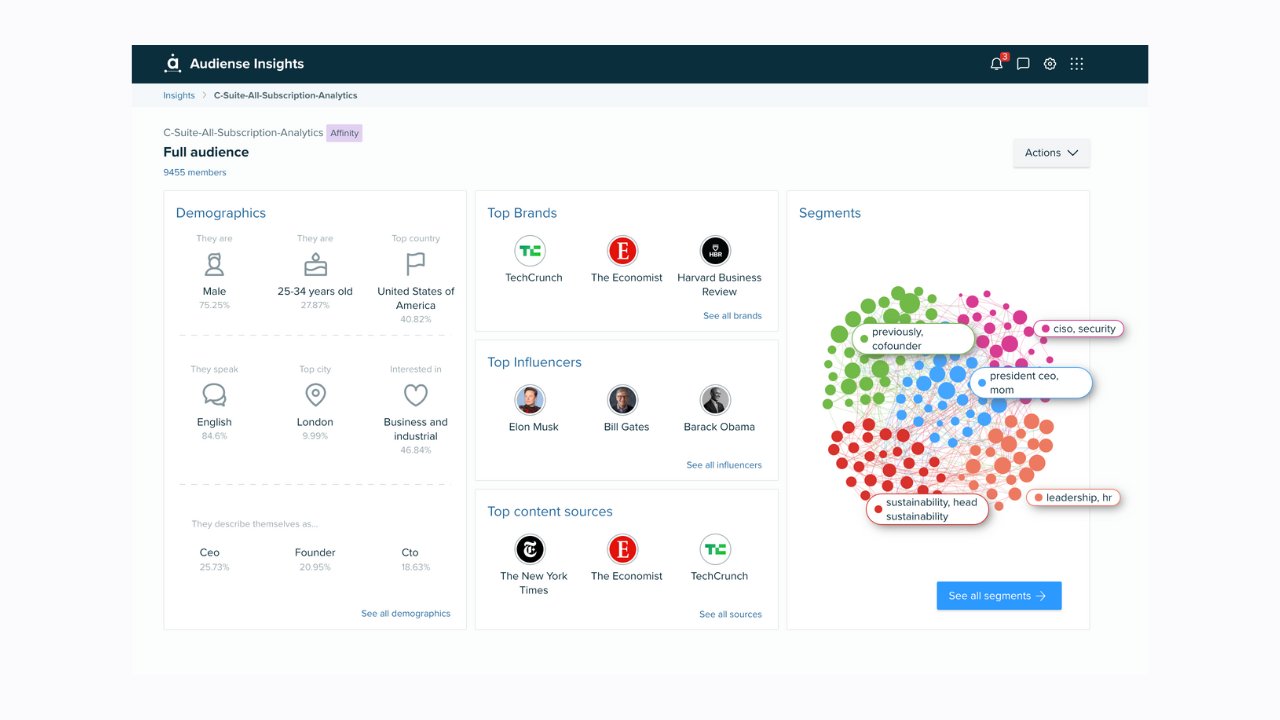
Bigwigs in this domain include Audiense, Affinio, and Helixa, but don’t just take my word for it—do some digging. Brandwatch Audiences also deserve a closer look. Audiense, for instance, segments data based on shared affinities and other factors.
Influencer Marketing Software: The Rundown
Influencer marketing software helps you pinpoint influencers by topic, location, or channel. Most platforms also assist in managing programs and tracking influencer campaigns.
The consumer marketplace differs significantly from the B2B landscape. Consumer brands tend to steal the limelight with the campaigns they launch and manage. This is partly because newer social networks like TikTok, Snapchat, and Instagram cater to younger audiences—millennials, Gen Z, and Gen Alpha—who fuel demand for all consumer products.
That’s why most innovation and efforts to develop new capabilities focus on these new channels. Leading influencer and social marketing software platforms include Tagger Media, CreatorIQ, Upfluence, Klear, Mavrck, and Captiv8.
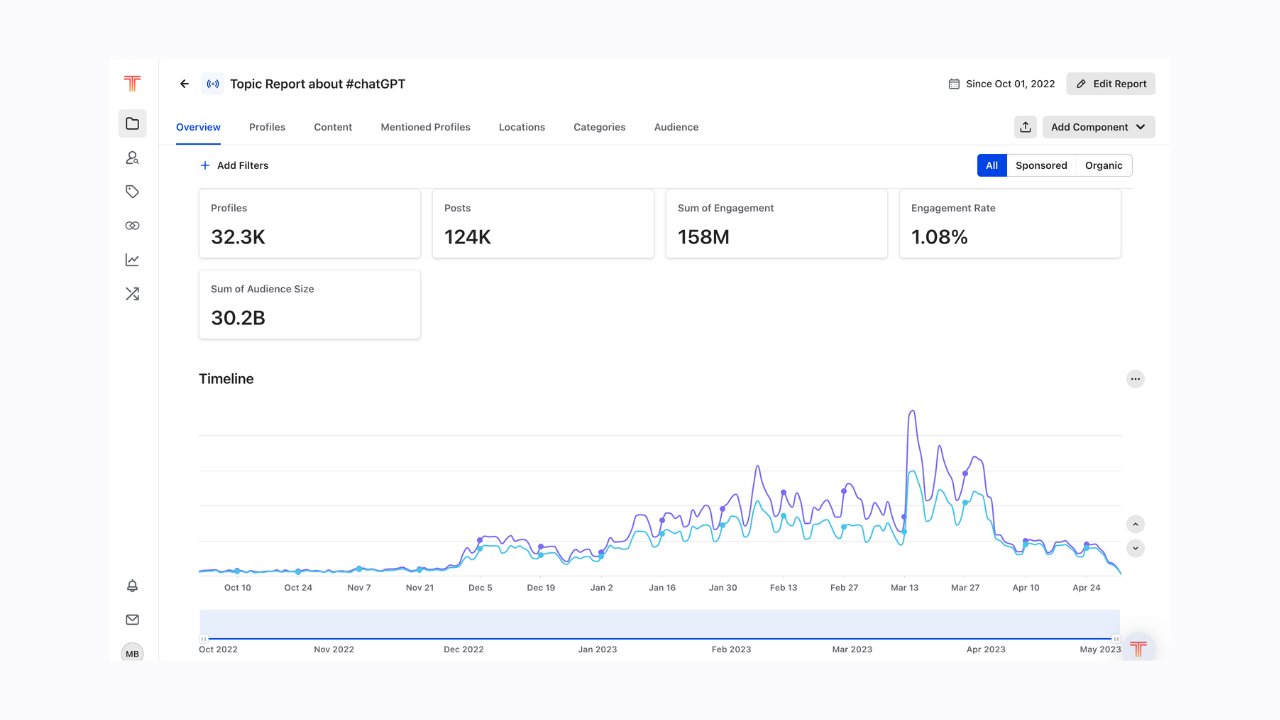
These influencer software providers essentially offer similar features and services. However, Tagger Media stands out by developing what could be dubbed a social listening platform for the creator community. Their social intelligence engine, Signals, gives unique insights into creator community content, posts, and profile data. None of the creator platforms mentioned earlier can hold a candle to this offering.
Unlocking the Power of Text Analysis and Network Mapping
Text analysis technologies like Quid and Graphext have become essential in today’s data-driven marketing landscape. These powerful tools do more than merely monitor social media chatter; they delve deep into the meaning and context behind the conversations. By dissecting and interpreting vast amounts of text data, brands can uncover valuable insights that drive more effective marketing strategies.
Take Quid, for example. This cutting-edge platform enables marketers to analyze text data from various sources, including news articles, blog posts, and social media posts. By harnessing natural language processing and machine learning, Quid can identify trends, sentiments, and patterns within the data. This level of analysis goes beyond mere keyword tracking, allowing brands to grasp the essence of the conversations and make data-driven decisions based on nuanced understanding.
Graphext, another powerful text analysis tool, transforms unstructured text data into insightful visualizations. Graphext can reveal hidden connections and relationships within the data through interactive network graphs and clustering algorithms. By visualizing complex data sets, marketers can better comprehend the underlying narratives and detect emerging themes that could shape their marketing campaigns.
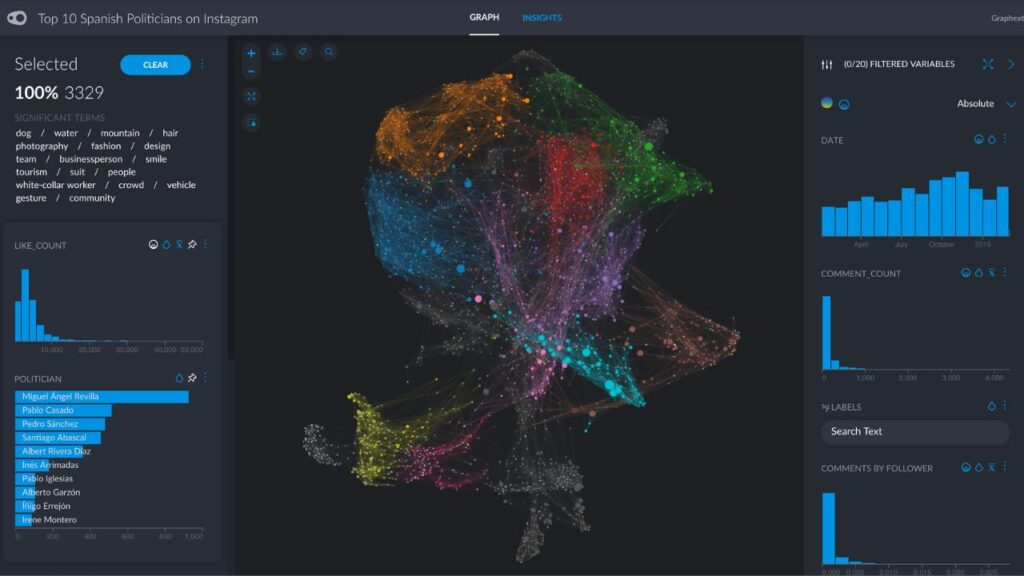
Complementing text analysis technologies, social network analysis tools like NodeXL offer a different perspective on the digital landscape. NodeXL allows marketers to map and analyze social networks, unveiling the intricate relationships connecting individuals and groups. By understanding network maps and group clustering, brands can identify influential voices and communities that hold sway over their target audiences.
Text analysis technologies and an enterprise social network analysis tools are indispensable for contemporary marketers. Beyond surface-level social monitoring, these advanced solutions provide a deeper understanding of the digital sphere’s meaning, context, and relationships. With this wealth of knowledge at their fingertips, brands can craft more targeted and effective marketing strategies, resonating with their audiences in a more authentic and impactful manner.
FAQ
The primary challenges in choosing the right social media software include cost, adoption, privacy, security concerns, and adapting to ever-changing platform policies and features.
Before selecting the software, start with a well-thought-out content strategy. This approach will guide your choice and ensure you pick a platform that aligns with your objectives and goals.
To maximize the benefits of your chosen software, create a content calendar, schedule posts, use automation and reporting, analyze data and content performance, engage with your audience, identify influencers, and stay updated with industry trends and platform changes.
For small businesses, popular options include Hootsuite, Sprout Social, Hubspot Marketing Hub, Buffer, Agorapulse, and Later. Enterprise brands can consider Sprinklr, Khoros, Salesforce Marketing Cloud, Falcon (acquired by Cision), and Meltwater.
Social media listening software helps monitor and analyze conversations across various platforms. Audience analysis software focuses on creating and dissecting audiences based on their media affinities and social media conversations. Finally, influencer marketing software identifies influencers by topic, location, or channel and assists in managing programs and tracking influencer campaigns.
